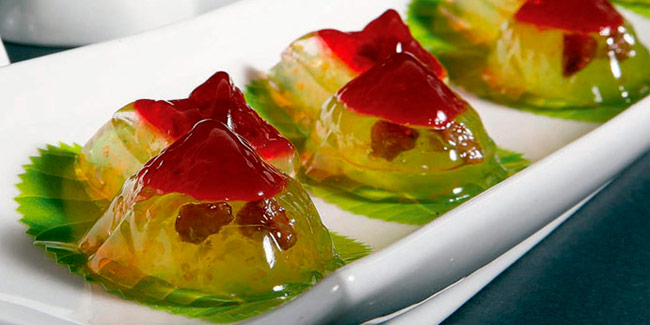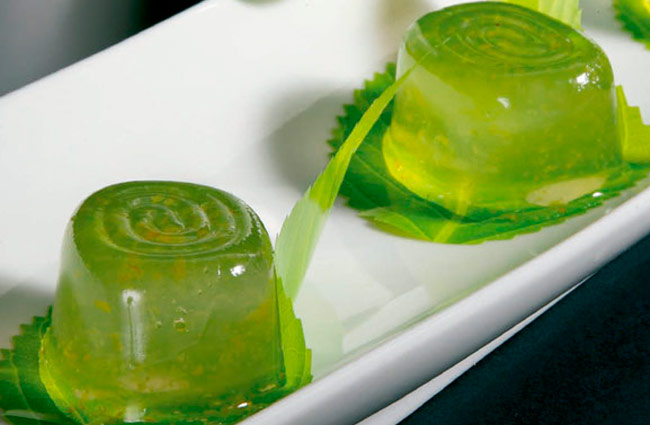Author:
Luis Concepción
TAGS #

Simple recipes, barely distinguishable in their composition, and ingredients that give a lot of play are enough for Japan to have created a rich tradition in jellies. Agar agar, candied red soybean paste (azuki), and white soybean paste (shiro nama an), water, sugar and, in some cases, yuzu, make up a small range of ingredients that serve as the basis for talking about jellies suitable for each season, with a different cut texture and elasticity. As with other Japanese pastry specialties, the name of the preparation itself usually indicates its main ingredient, its density and texture.
In recent years, at So Good we have become aware of the importance of jelly in everyday Japanese pastry through, above all, one of Grupo Editorial Vilbo’s closest collaborators, Takashi Ochiai, from the Ochiai Pastry Shop in Barcelona. Let’s see some of its most significant jellies.
Kin Joku Kan

Spring brings with it a truly remarkable variety of jellies. One of the best known is Kin Joku Kan (spring), with which the Japanese welcome this season. The star component is the citrus yuzu and it can have several formats, one of the most common is that of fish. They are shaped with white ceramic molds.
Ingredients
- 3 g agar-agar
- 225g water
- 200g sugar
- 20g glucose
- 2g citric acid
- yuzu paste
Elaboration

Bring the water to a boil and add agar. Once dissolved, add the glucose, sugar, and keep the heat on until the ingredients are fully integrated. Then add citric acid and yuzu paste and mix well. Separate part of the mixture and add red food coloring until you get the desired color. Moisten the fish-shaped ceramic molds with water. Distribute the red jelly on the part of the tail. Fill the container with transparent gelatin until it reaches the height of the eyes, place two half raisins in the holes corresponding to the eyes and fill the mold with the rest of the transparent gelatin. Let cool and unmold. For another finish, fill an oval white ceramic mold with the same yuzu jelly. Let cool and unmold.
Yokan jellies
With the ending “yōkan” an assortment of jellies is defined that are usually sold in the form of blocks and consumed in slices. Below, we go over some of the most important ones.
1. Mizu Yōkan

Let us remember that in Japan high temperatures are accompanied by high ambient humidity. In this context, jellies are a good palliative to deal with the heat. One of them is Mizu Yokan. “Mizu” precisely means that it is an elaboration with a more watery texture, cooler, ideal for summer. It is made up of a candied red soybean mass that provides less sweetness than other preparations prepared with candied white soybeans.
2. Matcha Yokan

It is denser and sweeter than the Mizu Yokan and, at the time of its launch, one of the sensations of the Ochiai Pastry Shop in Barcelona. It is made with candied white soybean (shiro nama an), which gives it sweeter and a milder flavor than the red soybean (shouzu nami an) of the Mizu Yokan. Matcha Yokan follows a delicate manufacturing process in which the addition of kanten (agar agar), and then sugar and previously mixed matcha green tea, must be carried out with care and rigor to achieve proper dissolution and adequate elasticity of the matcha jelly. It is an ideal sweet to eat with Japanese green tea.
3. Neri Yokan

It is made with candied red soybeans (azuki), glucose, and a pinch of salt
Ingredients
- 7.5g agar agar
- 150g sugar
- 150g glucose
- 750 g candied red beans
- 600g water
- 2.5g salt
Elaboration
Mix the agar agar and sugar. Separately, bring a pan of water to a boil and add the mixture of sugar and agar agar. Then add glucose and salt. Wait until it boils again and at the end of this process add the candied red bean. Place in molds and then remove once it sets.
Survival Guide
Azuki: Red soybeans. Currently, it is the second most consumed legume in Japan
Shiro nama an: Candied White Soybeans
Anko: Traditional elaboration, stuffed with endless Japanese pastry products
Kanten: Agar agar



